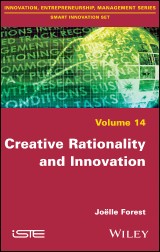Details
Creative Rationality and Innovation
1. Aufl.
|
139,99 € |
|
| Verlag: | Wiley |
| Format: | EPUB |
| Veröffentl.: | 30.11.2017 |
| ISBN/EAN: | 9781119476672 |
| Sprache: | englisch |
| Anzahl Seiten: | 192 |
DRM-geschütztes eBook, Sie benötigen z.B. Adobe Digital Editions und eine Adobe ID zum Lesen.
Beschreibungen
<p>This book urges us to be creative in our way of thinking about innovation. Adopting an artificial perspective, the author emphasizes creative rationality: a form of thought that encourages knowledge crossing and invites an adventurous transgression. The question of how such a form of thought might be developed is addressed through a detailed examination of the educational system. The book frees itself from many of the myths that surround innovation, including the predominance of what the author calls the linear and hierarchical model.</p>
<p>Foreword ix</p> <p>Introduction xiii</p> <p><b>Chapter 1. Innovation: What Exactly Are We Talking About? 1</b></p> <p>1.1. Some key distinctions 2</p> <p>1.1.1. Distinguishing innovation from discovery and invention 2</p> <p>1.1.2. What is the distinction between invention and innovation founded upon? 3</p> <p>1.2. Typology of innovations based on their purpose 8</p> <p>1.3. Typology of innovations based on their scale 10</p> <p>1.4. Reasons for innovation 13</p> <p><b>Chapter 2. Thinking about Innovation Differently 17</b></p> <p>2.1. Innovation in society 17</p> <p>2.2. Schumpeter’s models of innovation 20</p> <p>2.3. From innovation as an outcome to the analysis of innovation as a process 22</p> <p>2.4. Contours of the linear and hierarchical model of innovation 24</p> <p>2.5. A fertile ground for the creation of the linear and hierarchical model of innovation 25</p> <p>2.5.1. The institutionalization of science 25</p> <p>2.5.2. The lack of technical thought 27</p> <p>2.6. Impact of the model with respect to the definition of research and innovation policies 28</p> <p>2.7. Limitation of the linear and hierarchical model 30</p> <p>2.7.1. Too much importance given to R&D 30</p> <p>2.8. The design process at the core of the innovation process 36</p> <p>2.9. The design process, what are we speaking about exactly? 40</p> <p>2.9.1. The two models of the design process according to L. Blessing 40</p> <p>2.9.2. The stages of the design process 41</p> <p>2.9.3. Overall convergence of the design process 42</p> <p>2.9.4. Rule-based design regime versus innovative design regime 44</p> <p>2.10. Validity of the model 46</p> <p><b>Chapter 3. Artificialism 51</b></p> <p>3.1. Artificial world as a set of artifacts 52</p> <p>3.2. Contribution of the Simonian theory to the understanding of the design process 55</p> <p>3.2.1. Bounded rationality and satisficing 55</p> <p>3.2.2. Design as a process obeying satisficing 56</p> <p>3.2.3. Specificities of the design process 60</p> <p>3.3. Simonian empiricism 61</p> <p>3.4. Key propositions of Artificialism 62</p> <p>3.5. Interest in thinking about innovation from the artificial perspective 68</p> <p>3.5.1. Developing a comprehensive organizational system to ensure the effectiveness and efficiency of the design process 69</p> <p>3.5.2. Thinking of the user 70</p> <p><b>Chapter 4. Innovating by Implementing Creative Rationality. 77</b></p> <p>4.1. Creative rationality: what exactly are we talking about? 78</p> <p>4.1.1. Thinking in terms of relation 78</p> <p>4.1.2. A form of thought that can replace the inexplicable with the rational 81</p> <p>4.2. The reality of creative rationality 84</p> <p>4.2.1. What are innovation biographies? 84</p> <p>4.2.2. The example of Gutenberg’s printing press 86</p> <p>4.2.3. The example of the printing press is not an isolated case 88</p> <p>4.2.4. Towards an adventurous transgression 90</p> <p>4.2.5. The Solar Impulse project 96</p> <p>4.2.6. A journey to the center of the production of knowledge 99</p> <p>4.2.7. The basis of a creative rationality model 99</p> <p>4.2.8. A limited production of knowledge 102</p> <p>4.2.9. A production of knowledge that must be interpreted beyond the reasoning at work 103</p> <p><b>Chapter 5. Creative Rationality and the Education System 107</b></p> <p>5.1. Teaching innovation: a political project 108</p> <p>5.2. A harmful confusion between innovation and entrepreneurship 110</p> <p>5.2.1. The Beylat–Tambourin report 110</p> <p>5.2.2. Confusion deriving from J. Schumpeter 112</p> <p>5.2.3. The skills of innovators versus the skills of entrepreneurs 114</p> <p>5.3. School environment and creative rationality 116</p> <p>5.3.1. Challenging traditional school 117</p> <p>5.3.2. The parable of the “flea trainer” 119</p> <p>5.3.3. An education system that kills creativity 122</p> <p>5.4. Rehabilitating creativity rationality in the training of engineers 125</p> <p>5.5. Towards the pedagogy of adventure 128</p> <p>5.5.1. Observing to innovate 129</p> <p>5.5.2. Otherness: recognizing the other 134</p> <p>5.5.3. How to move from the idea of pedagogy of adventure to its implementation? 137</p> <p>Conclusion 147</p> <p>Bibliography 149</p> <p>Index 163</p>
Joëlle Forest, National Institute of Applied Sciences of Lyon, France



















